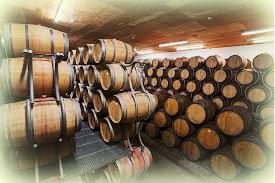The production of wine begins with the harvesting of grapes. The grape variety used in making wine is the species Vitis vinifera. Once gathered, the grapes go through a ‘destemming’ process that removes them from the rachis. This is followed by crushing, wherein pressure is applied to squeeze grapes into mush (wine must). The next stage is fermentation.
Fermentation is the process wherein yeast consumes sugar and turns it into alcohol. Wine fermentation has two stages: primary and secondary. During primary fermentation, the fermentation tank is exposed to air for three to five days. Exposure to open air encourages yeast cell reproduction. During secondary fermentation, air exposure is reduced. At this stage, yeast stops multiplying and begins to produce alcohol.

Wine Storage in Oak Wine Barrels
After fermentation, the wine is transferred to another container in order to separate it from residual yeast and other sediments. Wine is then drained into oak barrels, concrete or metal vats, or carboys for further aging and enhancement of flavor. Wine needs to be aged for the right amount of time before bottling. White wines should be aged at least half a year and red wines for at least a year.
Wines that are newly bottled should be allowed to sit upright for three days. After three days, wine bottles are laid on their side to allow the cork to come in contact with the wine. Newly bottled wine should be aged for a few months more before consumption, as this will give it time to improve and attain its full potential.
After the production process, wines are sold and distributed to various wine merchants. Although wines get better over time, they can easily deteriorate as well. In order to maintain their quality, wines should be stored in an environment wherein there is minimal to no fluctuation. There are five factors to consider regarding proper wine storage: temperature, humidity, light, vibration and odor.
Temperature and humidity can be constantly maintained at their ideal range with the help of wine cellar cooling systems. The ideal wine storage temperature is between 50 and 60 degrees Fahrenheit, and the right amount of humidity is within a 60% – 75% range.
If the level of temperature is unstable, it can hasten the aging process and ruin the quality of wines. Humidity is essential to wine storage, but it needs to be regulated because it can cause mold growth or dry out the corks when left to its own accord.
The purpose of wine cellar refrigeration systems is to provide balance and stability in wine storage rooms. Most wine cellars are installed with wine cellar cooling units, to help regulate temperature and humidity levels inside the storage space. In addition to wine cellar refrigeration systems, wine cellars are also designed with proper insulation and vapor barriers to help maintain the required climate conditions for aging wines.
Continuous light exposure can also be damaging to wines. Hence, wine cellars need to have just the right amount of light in order to find the appropriate wine bottle, to move about the room, and to view wine labels. Installing additional features like dimmer switches and light timers can help reduce exposure of wine bottles to light sources as well.
The storage environment should be free of unsavory smells, and secured against vibration. Odor and vibratory motion can negatively impact the chemistry of wines.
Keep in mind that storing bottled wines is as meticulous as the wine making process. When the proper methods of wine storage are applied, the preservation of the finer qualities of wine should last for a long time.
Visit US Wine Cellar Refrigeration Systems to check out the effective wine storage equipment they offer.










